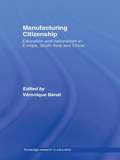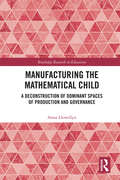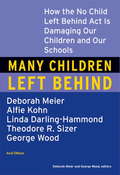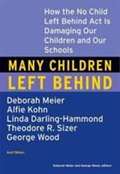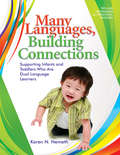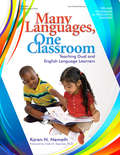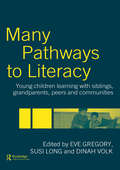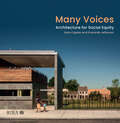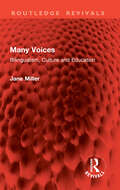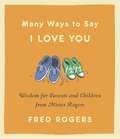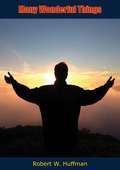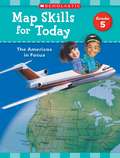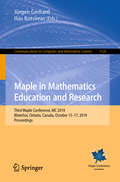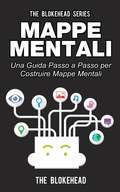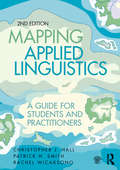- Table View
- List View
Manufacturing Citizenship: Education and Nationalism in Europe, South Asia and China (Routledge Research in Education)
by Véronique BénéïIn recent years citizenship has emerged as a very important topic in the sciences, mainly as a result of the effects of migration, population displacements and cultural heterogeneity. This book focuses on educational enterprise and how it affects national ambitions, cultural preferences and political trends. It also examines the major effects of globalisation, the large-scale movements of populations, and the impact this all has in terms of education and citizenship. With contributions from an array of international scholars including Etienne Balibar, and featuring various international case studies, Manufacturing Citizenship will be extremely interesting to the education academic community as well as many readers within cultural studies and politics.
Manufacturing Consent
by Mark AchbarManufacturing Consent Noam Chomsky and the Media, the companion book to the award-winning film, charts the life of America's most famous dissident, from his boyhood days running his uncle's newsstand in Manhattan to his current role as outspoken social critic.A complete transcript of the film is complemented by key excerpts from the writings, interviews and correspondence. Also included are exchanges between Chomsky and his critics, historical and biographical material, filmmakers' notes, a resource guide, more than 270 stills from the film and 18 "Philosopher All-Stars" Trading Cards!Mark Achbar has applied a wide range of creative abilities and technical skills to over 50 films, videos, and books. He has worked as editor, researcher and production coordinator."A juicily subversive biographical/philosophical documentary bristling and buzzing with ideas."--Washington Post"You will see the whole sweep of the most challenging critic in modern political thought."--Boston Globe"One of our real geniuses, an excellent introduction."--Village Voice"An intellectually challenging crash course in the man's cooly contentious analysis, laying out his thoughts in a package that is clever and accessible."--Los Angeles TimesContents:The Man. Early Influences. Vietnam A Turning Point. On His Role. The Media. Thought Control in Democratic Societies. A Propaganda Model. The Gulf "War". A Case Study Cambodia & East Timor. Concision A Structural Constraint. "Sports Rap with Noam Chomsky." A Cabal of Anti-Conspiricists. Media in Media, Pennsylvania. Alternative Media. The Linguist. Basic Premises. Nim Chimsky: Chimpanzee. And the Elusive Connection to his Politics. The Social Order. On Education. Anarchism/Libertarian Socialism. Resistance & Critical Analysis. The Critics (Media-Based). William F. Buckley, Jr. "Firing Line". David Frum Journalist, Washington Post. Jeff Greenfield Producer, "Nightline". Karl E. Meyer Editorial Writer, The New York Times. Peter Worthington Editor, The Ottawa Sun. The Critics (Other Elites). Fritz Bolkestein Former Dutch Minister of Defense. Michel Foucault Philosopher. Yossi Olmert Tel Aviv University. John Silber
Manufacturing Morals: The Values of Silence in Business School Education
by Michel AntebyCorporate accountability is never far from the front page, and as one of the world's most elite business schools, Harvard Business School trains many of the future leaders of Fortune 500 companies. But how does HBS formally and informally ensure faculty and students embrace proper business standards? Relying on his first-hand experience as a Harvard Business School faculty member, Michel Anteby takes readers inside HBS in order to draw vivid parallels between the socialization of faculty and of students. In an era when many organizations are focused on principles of responsibility, Harvard Business School has long tried to promote better business standards. Anteby's rich account reveals the surprising role of silence and ambiguity in HBS's process of codifying morals and business values. As Anteby describes, at HBS specifics are often left unspoken; for example, teaching notes given to faculty provide much guidance on how to teach but are largely silent on what to teach. Manufacturing Morals demonstrates how faculty and students are exposed to a system that operates on open-ended directives that require significant decision-making on the part of those involved, with little overt guidance from the hierarchy. Anteby suggests that this model--which tolerates moral complexity--is perhaps one of the few that can adapt and endure over time. Manufacturing Morals is a perceptive must-read for anyone looking for insight into the moral decision-making of today's business leaders and those influenced by and working for them.
Manufacturing Morals: The Values of Silence in Business School Education
by Michel AntebyCorporate accountability is never far from the front page, and as one of the world’s most elite business schools, Harvard Business School trains many of the future leaders of Fortune 500 companies. But how does HBS formally and informally ensure faculty and students embrace proper business standards? Relying on his first-hand experience as a Harvard Business School faculty member, Michel Anteby takes readers inside HBS in order to draw vivid parallels between the socialization of faculty and of students. In an era when many organizations are focused on principles of responsibility, Harvard Business School has long tried to promote better business standards. Anteby’s rich account reveals the surprising role of silence and ambiguity in HBS’s process of codifying morals and business values. As Anteby describes, at HBS specifics are often left unspoken; for example, teaching notes given to faculty provide much guidance on how to teach but are largely silent on what to teach. Manufacturing Morals demonstrates how faculty and students are exposed to a system that operates on open-ended directives that require significant decision-making on the part of those involved, with little overt guidance from the hierarchy. Anteby suggests that this model—which tolerates moral complexity—is perhaps one of the few that can adapt and endure over time.Manufacturing Morals is a perceptive must-read for anyone looking for insight into the moral decision-making of today’s business leaders and those influenced by and working for them.
Manufacturing Religion: The Discourse on Sui Generis Religion and the Politics of Nostalgia
by Russell T. McCutcheonIn this book, author Russell McCutcheon offers a powerful critique of traditional scholarship on religion, focusing on multiple interrelated targets. Most prominent among these are the History of Religions as a discipline; Mircea Eliade, one of the founders of the modern discipline; recent scholarship on Eliade's life and politics; contemporary textbooks on world religions; and the oft-repeated bromide that "religion" is a sui generis phenomenon. McCutcheon skillfully analyzes the ideological basis for and service of the sui generis argument, demonstrating that it has been used to constitute the field's object of study in a form that is ahistoric, apolitical, fetishized, and sacrosanct. As such, he charges, it has helped to create departments, jobs, and publication outlets for those who are comfortable with such a suspect construction, while establishing a disciplinary ethos of astounding theoretical naivete and a body of scholarship to match. Surveying the textbooks available for introductory courses in comparative religion, the author finds that they uniformly adopt the sui generis line and all that comes with it. As a result, he argues, they are not just uncritical (which helps keep them popular among the audiences for which they are intended, but badly disserve), but actively inhibit the emergence of critical perspectives and capacities. And on the geo-political scale, he contends, the study of religion as an ahistorical category participates in a larger system of political domination and economic and cultural imperialism.
Manufacturing the Mathematical Child: A Deconstruction of Dominant Spaces of Production and Governance (Routledge Research in Education)
by Anna LlewellynMathematics is a subject held in high esteem around the world, yet the teaching and learning of mathematics is rarely viewed as good enough and many find the subject difficult to comprehend, or engage with. In Manufacturing the Mathematical Child, Anna Llewellyn asks some difficult questions in order to determine why this is the case and to question who it is that we allow to succeed at mathematics, particularly within the context of neoliberalism, where education is a product of the market. By looking at the various sites of production, Llewellyn examines the ways that key discursive spaces produce very different expectations of what it means to do mathematics and demonstrates that these place various homogenised expectations upon children. Arguing that these are not natural, but instead a reproduction of discursive norms, the book demonstrates why some people fit these standardized ways of being and others do not. Using England as a case study and referring to other international contexts, Llewellyn argues that there is a functionality found within certain educational policy discourses, and a romantic attachment to the natural child found within educational research, neither of which can match what happens in the messy classroom. As a result, it becomes evident that exclusion from mathematics is inevitable for many children. Original and exciting, this book will be of great interest to academics, researchers and postgraduate students within the fields of mathematics education, childhood studies, policy studies, and Foucauldian or post-structural analysis.
Many Children Left Behind
by Deborah MeierSigned into law in 2002, the federal No Child Left Behind Act (NCLB) promised to revolutionize American public education. Originally supported by a bipartisan coalition, it purports to improve public schools by enforcing a system of standards and accountability through high-stakes testing. Many people supported it originally, despite doubts, because of its promise especially to improve the way schools serve poor children. By making federal funding contingent on accepting a system of tests and sanctions, it is radically affecting the life of schools around the country.But, argue the authors of this citizen's guide to the most important political issue in education, far from improving public schools and increasing the ability of the system to serve poor and minority children, the law is doing exactly the opposite. Here some of our most prominent, respected voices in education-including school innovator Deborah Meier, education activist Alfie Kohn, and founder of the Coalition of Essential Schools Theodore R. Sizer-come together to show us how, point by point, NCLB undermines the things it claims to improve:* How NCLB punishes rather than helps poor and minority kids and their schools * How NCLB helps further an agenda of privatization and an attack on public schools * How the focus on testing and test preparation dumbs down classrooms * And they put forward a richly articulated vision of alternatives. Educators and parents around the country are feeling the harshly counterproductive effects of NCLB. This book is an essential guide to understanding what's wrong and where we should go from here. From the Trade Paperback edition.
Many Children Left Behind: How the No Child Left Behind Act Is Damaging Our Children and Our Schools
by Deborah Meier George WoodThe No Child Left Behind (NCLB) Act is counterproductive and destructive to the goal of improving public education in the United States, collectively argue the contributors of these six essays. They describe how the "test and punish" regime of the NCLB, because disabilities are strongly correlated with poverty, will further damage the ability of schools in poor communities to provide for their students as they fall behind in testing scores and are punished for it financially. They also explore how the NCLB can be considered a Trojan horse for school privatization and put forth an alternative agenda for school reform.
Many Infallible Proofs: Evidences for the Christian Faith (The Henry Morris Signature Collection)
by Henry MorrisEvidence for the inspiration of the Bible, the deity of Christ, testimony of fulfilled prophecy, and the argument for the existence of the God of the Bible The uniqueness of Christianity, authenticity of God’s Word, and character of God Many people in Christian circles today no longer believe that the Bible is reliable in its traditional literal and historical sense. They have come to feel that their religious experience must be realized either through some sort of subjective “encounter” with Christ or else through involvement in social action movements. The emphasis is now on “relevance” and “fulfillment,” rather than truth. The purpose of this book is to survey the “many infallible proofs” of the unique truth and authority of biblical Christianity, together with a refutation of its alleged fallacies and a reconciliation of its alleged discrepancies. Not only is there no mistake or contradiction in the Bible, but also there are innumerable evidences of its divine inspiration and authority.
Many Languages, Building Connections: Supporting Infants and Toddlers Who Are Dual Language Learners
by Karen NemethAll infants and toddlers need experiences that nurture, support, and teach their home language and culture. Language is a vital component of early experiences well before a child can say his first word. Infants and toddlers whose families come from diverse backgrounds and speak different languages are appearing in all kinds of early care and learning settings in growing numbers. Even the most experienced caregiver can feel a bit unsure about meeting the unique needs of infants and toddlers from different language backgrounds.Many Languages, Building Connections outlines adaptable strategies that caregivers of children younger than the age of three need to feel confident that they know how language develops, how cultural differences can come into play, and how to assess an individual child's situation to provide appropriate support. From welcoming diverse families and engaging them to participate in a child care program to creating nurturing communities that value and support each child's home language while also fostering English acquisition, the helpful strategies in Many Languages, Building Connections will prepare caregivers for the diverse reality they encounter in their work.
Many Languages, One Classroom: Teaching Dual and English Language Learners
by Karen NemethIn classrooms across the country, teachers are encountering more children who are learning English, come from diverse backgrounds, and who speak a variety of languages. As challenging as this may be, a preschool teacher's goal remains the same: to welcome all children and give them the best possible start in education and in life. Even the most experienced teacher can feel a bit unsure about meeting the unique needs of children from different language backgrounds. Many Languages, One Classroom applies the latest information about best practices to all aspects of a preschool program. From using lists of key words and visual aids to using body language and gestures, the strategies you will find in this book are adaptable and easy to put into practice. Designed to fit any preschool curriculum, Many Languages, One Classroom addresses state standards and benchmarks of standard quality programming. Organized by interest areas and times of the day, you'll find everything you need to help English language learners during dramatic play, outdoor play, reading, science, blocks, and circle time.
Many Pathways to Literacy: Young Children Learning with Siblings, Grandparents, Peers and Communities
by Eve Gregory Dinah Volk Susi LongThis unique and visionary text is a compilation of fascinating studies conducted in a variety of cross-cultural settings where children learn language and literacy with siblings, grandparents, peers and community members. Focusing on the knowledge and skills of children often invisible to educators, these illuminating studies highlight how children skilfully draw from their varied cultural and linguistic worlds to make sense of new experiences. The vastly experienced team of contributors provide powerful demonstrations of the generative activity of young children and their mediating partners - family members, peers, and community members - as they syncretise languages, literacies and cultural practices from varied contexts. Through studies grounded in home, school, community school, nursery and church settings, we see how children create for themselves radical forms of teaching and learning in ways that are not typically recognised, understood or valued in schools. This book will be invaluable reading for teachers, teacher educators, researchers and policy-makers who seek to understand the many pathways to literacy and use that knowledge to affect real change in schools.
Many Voices: Architecture for Social Equity
by Sara Caples Everardo JeffersonDo you know how to create beautiful buildings that truly promote social change? Architects need to understand how to design for social equity, but too often this is presented as a choice between work that does good and work that looks good. When done well, building for social equity can directly enhance the formal, experimental and creative language of architecture. Renowned architects Sara Caples and Everardo Jefferson, who have been designing for underserved multi-cultural communities in New York for decades, provide thought leadership that is deeply rooted in practice. By urging architects to approach equity projects with an open mind, the volume highlights the need to dig deep into the diverse culture of local neighbourhoods. It provides techniques to encourage listening, communicating and fully engaging with users, resulting in imaginative design responses that draw on all the tools that the architect possesses. Packed with interviews from established and up-and-coming designers, and highly illustrated case studies from all over the world, this accessibly written book serves both as a point of inspiration and a challenge to Western-centric ways of working. Ultimately, it explores how listening to the aspirations of diverse communities enriches designs and broadens the architectural language of all involved. Featuring: International case studies from Austria, Brazil, Bolivia, China, Egypt, India, USA and many more Interviews from leading designers, including: Tatiana Bilbao, Wanda Dalla Costa, Andres Lepik, Xu Tiantian, Li Xiaodong, Sara Zewde Guidance on a range of topics, from integrating narratives to working with colour, communicating with communities and stakeholders to ethical practice
Many Voices: Bilingualism, Culture and Education (Routledge Revivals)
by Jane MillerAttitudes to bilingualism have always been contradictory. The possession of more than one language has been thought to be an advantage, even a necessity, while simultaneously being regarded as an inconvenience, sometimes a disastrous one. Yet more than half the world’s population is bilingual. Britain is also now a multilingual society. It is therefore important to understand the phenomenon of bilingualism and to unravel the contradictions in attitudes towards it. In her book Many Voices (originally published in 1983 and now with a new foreword by John Yandell), Jane Miller has set out to listen to children and to adults—some of whom are well-known writers—for whom bilingualism is undeniably an asset.If there are advantages to being bilingual, there are also problems: personal, social, and inevitably, political ones. Jane miller moves from individual testimonies to their cultural and educational implications. It may be, she suggests, that we can gain from the strengths of bilingual speakers’ knowledge which could enrich schooling and the curriculum for all children. By attending to the experiences of people who have had to make their way within a new society, we learn something about how all individuals construct their identities out of cultural difference. Language, languages are central to this. Jane Miller argues that bilingualism allows for a special focus on developments in culture generally which is useful to teachers, linguists, readers of literature, and makers of educational policy.
Many Ways to Say I Love You: Wisdom for Parents and Children from Mister Rogers
by Fred RogersInspirational words on parenting from the beloved PBS series Mister Rogers' Neighborhood, for new parents and those whose children are grown. Fred Rogers has long been a wonderful resource for parents, offering their children entertainment and education through his enduring television show. Now his special brand of good cheer and wisdom are brought together especially for parents in this newest book based on never-before-published works.Many Ways to Say I Love You is a treasury of segments from speeches and observations from his years of working with parents and children, as well as other materials from books, songs, TV commentary, and more. Using stories from his own life, Mister Rogers discusses the importance of children and the role of parents.
Many Wonderful Things
by Robert Huffman“SOMETIMES GOD TAKES UNUSUAL METHODS TO ATTRACT ATTENTION TO HIMSELF…”This book brings you the amazing true story of one of the most unusual events of our day—proof through hypnosis that God has placed a part of Himself within you!In a series of hypnotic experiments carried out over a period of two years, the Boulder Fellowship Foundation has uncovered startling evidence that man has a “third mind—a God mind, a part of God within himself. While hypnotism is not the theme of this book, it was the tool used to show that the subconscious mind—as well as the conscious mind—can be stilled, thus allowing the God-part to speak without the intrusion of the ego. The result?—pure truth brought forth from the God part at the God level!The answers to questions put to the God-part of the subject used in these experiments are truly amazing. As you read them in this book, they will speak of many wonderful things, and point the way to your greatest adventure—partnership with God…adventure into Eternity!“Proving God within ourselves is an adventure, a challenge, a joy,” the God-part tells us. “Now is the time to claim this challenge, to step forth to this adventure. For this is our one requirement: to recognize God within, to express God from ourselves to all men; thus bringing forth the greatest, the most glorious adventure in all eternity!”THE GOD-PART SPEAKS TRUTH WITH NO CONFUSION!The hypnotic experiments reported in this book uncover some revealing answers to scores of perplexing questions. Here are just a few:Where can I find God?How can I get to God?What is God like?How can I truly contact Him?Is here really life after death?What is man’s destiny?How can I find true peace of mind?Does God punish us?Is there really a Hell?What is death?What is God’s will for me?What is the greatest power in the Universe?Can God heal me? Will He?Read the easy-to-understand answers to these and many more questions in this book.
Mao Mao's Perfectly Imperfect Day
by Laan ChamA free-spirited new student helps a perfectionist panda embrace his more spontaneous side in this charming classroom story.Mao Mao strives for everything to be absolutely, 100%...PERFECT!But when Olivia joins his class, Mao Mao realizes that not everyone is this way. Olivia is messy. And noisy. And clumsy. So, Mao Mao decides to teach Olivia the art of how to be *PERFECT.* How hard could it be?With speech balloons and kawaii-influenced illustrations by Laan Cham, this relatable picture book celebrates individuality and self-expression and invites little ones to redefine what it means to be "perfect." It also champions embracing differences and learning from one another—an important lesson for any child starting school.
Mao's Great Famine: The History of China's Most Devestating Catastrophe 1958-62
by John Wagner GivensThe power of Frank Dikötter's ground-breaking work on the disaster that followed China's attempted ‘Great Leap Forward’ lies not in the detail of his evidence (though that shows that Mao's fumbled attempt at rapid industrialization probably cost 45 million Chinese lives). It stems from the exceptional reasoning skills that allowed Dikötter to turn years of researching in obscure Chinese archives into a compelling narrative of disaster, and above all to link two subjects that had been treated as distinct by most of his predecessors: the extent of the crisis in the countryside, and the actions (hence the responsibility) of the senior Chinese leadership. In Dikötter's view, ultimate responsibility for the catastrophe lies at the door of Mao Zedong himself; the Chairman conceived and ordered the policies that led to the famine, and he did nothing to reverse them or limit the damage that was being wrought when evidence for their disastrous impact reached him. Dikötter's ability to persuade his readers of the fundamental truth of these arguments – despite his admission that his access to sources was necessarily limited and incomplete – together with the clear structure of his presentation combine to produce a work that has had enormous influence on perceptions of Mao and of the Great Leap Forward itself.
Map Art Lab: 52 Exciting Art Explorations in Map Making, Imagination, and Travel (Lab)
by Jill K. Berry Linden McNeillyExplore the world of cartography with this collection of creative map-related projects—for artists of all ages and experience levels.This fun and creative book features fifty-two map-related activities set into weekly exercises, beginning with legends and lines, moving through types and styles, and then creating personalized maps that allow you to journey to new worlds. Authors Jill K. Berry and Linden McNeilly guide you through useful concepts while exploring colorful, eye-catching graphics.Maps are beautiful and fascinating, they teach you things, and they show you where you are, places you long to go, and places you dare to imagine. The labs can be used as singular projects or to build up to a year of hands-on creative experiences. Map Art Lab is the perfect book for map lovers and DIY-inspired designers. Artists of all ages and experience levels can use this book to explore enjoyable and engaging exercises.“Learn about cartography, topography, legends, compasses, and more in this adventurous DIY map book.” —Cloth Paper Scissors Magazine“Every art teacher should have a copy of this book.” —Katharine Harmon, author of The Map as Art: Contemporary Artists Explore Cartography
Map Skills For Today: Grade 5 (Map Skills For Today Ser.)
by Staff Scholastic IncWhy are there different time zones and how does Earth's rotation affect the seasons? These questions and others are answered in this activity book that helps students develop a rich understanding of the world's geography by looking at projection maps, political maps, and time zones. It also features specialty maps showing historic highways, early U.S. settlements, and transportation routes. Includes maps of Canada and our neighbors to the south!
Mapa para educar niños felices
by Susanna IsernEncuentra el camino en la educación de tus hijos con Susanna Isern. ¿Cuántas veces has sentido que no terminas de hallar el camino en la educación de tus hijos? Para nuestros hijos, a menudo somos como un mapa que los guía en sus primeros pasos por la vida y, sin embargo, muchas veces nos desorientamos tanto con su educación que los que acabamos necesitando un mapa somos los padres. ¿Cómo conseguir una comunicación fluida, empática, asertiva y bidireccional? ¿Cómo fomentar que mi hijo se acepte y se quiera? ¿Cómo promover que mi hijo identifique y regule sus emociones y aborde los nuevos retos con positividad? ¿Cómo enfocar la educación de la conducta de mi hijo? ¿Cómo potenciar que mi hijo se sienta feliz hoy y mañana? Con este Mapa para educar niños felices emprenderemos un gran viaje, plano en mano, circulando por los aspectos más importantes de la crianza: la comunicación, la autoestima, la inteligencia emocional, la conducta y los valores, así como por las principales herramientas de las que disponemos para abordarlos. Este libro te ofrece un mapa donde encontrarás las teorías, las experiencias y las reflexiones, los cuentos, las actividades y los casos prácticos necesarios. Todo un periplo impregnado de cariño, respeto y sentido común, para que cada familia encuentre su propio camino y viva la crianza de sus hijos como lo que siempre es, un maravilloso viaje.
Mapas Mentales ¡La Guía del Principiante Para Crear Mapas Mentales Paso a Paso!
by The BlokeheadEl mapeo mental se está volviendo cada vez más popular conforme avanzan los años. Comparado con métodos tradicionales de lluvia de ideas, estudiar y tomar notas linealmente, el mapeo mental es considerado 15%-20% más efectivo para ayudar a la memoria y mejorar el aprendizaje. Mucha gente está también aprendiendo que las tareas se vuelven más fáciles y que los problemas complejos se resuelven más rápido cuando se usa el mapeo mental. Este fenómeno podría atribuirse a cómo funciona el cerebro. Un corto análisis de cómo el cerebro procesa los datos puede revelar el misterio del éxito del mapeo mental. ¡Comienza a dominarlo!
Maple in Mathematics Education and Research: Third Maple Conference, MC 2019, Waterloo, Ontario, Canada, October 15–17, 2019, Proceedings (Communications in Computer and Information Science #1125)
by Jürgen Gerhard Ilias KotsireasThis book constitutes the refereed proceedings of the third Maple Conference, MC 2019, held in Waterloo, Ontario, Canada, in October 2019. The 21 revised full papers and 9 short papers were carefully reviewed and selected out of 37 submissions, one invited paper is also presented in the volume. The papers included in this book cover topics in education, algorithms, and applciations of the mathematical software Maple.
Mappe mentali. Una guida passo a passo per costruire mappe mentali
by The Blokeheadle mappe mentali stanno diventando sempre più popolari nel corso degli anni. Paragonate ad altri metodi, come il brainstorming e le annotazioni, la mappatura mentale sembra essere più efficace del 15-20% nel migliorare le capscità mnestiche e il proccesso di apprendimento. Molte persone, inoltre, affermano che l'uso delle mappe ha migliorato il loro modo di approcciare ai compiti, rendendoli più semplici, e ha ridotto i tempi di risoluzione dei problemi personali e professionali. L'insieme di questi risultati può essere attribuito a una corrispondenza tra le caratteristiche della mappatura eil modo in cui funziona il cervello. Attraverso una breve revisione del funzionamento cerebrale è possibile capire il motivo per cui le mappe determinano tali risultati. Questo manuale si pone lo scopo di insegnarvi ad usare le mappe mentali.
Mapping Applied Linguistics: A Guide for Students and Practitioners
by Christopher J. Hall Rachel Wicaksono Patrick H. SmithMapping Applied Linguistics: A guide for students and practitioners, second edition, provides a newly updated, wide-ranging introduction to the full scope of applied linguistics. This innovative book maps the diverse and constantly expanding range of theories, methods and issues faced by students and practitioners around the world, integrating both sociocultural and cognitive perspectives. Practically oriented and ideally suited to students new to the discipline, Mapping Applied Linguistics provides in-depth coverage of: multilingualism, language variation and Global Englishes literacy, language teaching and bilingual education discourse analysis language policy and planning lexicography and translation language pathology and forensic linguistics The new second edition features contemporary examples of global applied linguistics research and practice, and includes updated further reading and new fieldwork suggestions for each chapter. The companion website at cw.routledge.com/textbooks/hall provides a wealth of additional learning material, including activities, flashcards and links to the latest online resources. Mapping Applied Linguistics is essential reading for students studying applied linguistics, TESOL, general linguistics and language and literacy education at the advanced undergraduate or master’s degree level. It also provides a gateway for practitioners and specialists seeking to better understand the wider scope of their work.
